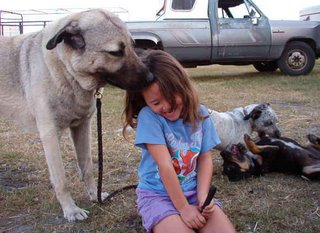 |
Purebred Turkish puppies or started dogs
available to the right homes. |
As always, I'm behind -- particularly on line!! We have exciting litters coming and a couple of started dogs for sale; however, there have also been developments in the field of livestock protection dogs that those who use working dogs -- or who support their use -- would certainly be interested in.
While I shared much of this information with Turkish friends on my 2010 trip there, I have now taken the liberty of reprinting information I wrote for the Fall 2012 ADAA Bulletin here. This is copyrighted information but I am happy to give permission for reprinting. Just contact me.
In May of 2010 an article entitled
“A Review: The Use of Livestock Protection Dogs in Association with Large Carnivores in the Rocky Mountains” by C. Urbigkit and S. Urbigkit was published in Sheep and Goat Research.
This article has been influential among government agencies, researchers, and livestock owners. It was the result of the Urbigkits’ travel through countries where livestock protection dogs are still used against large predators. Their travels were motivated by the need to find a better way for livestock producers here to discourage predation by northern wolves and grizzly bears. As Wyoming sheep ranchers, the Urbigkits were personally familiar with the problems facing livestock owners.
Spanish Mastiffs, Bulgarian Karakachan Dogs, and Turkish Kangal Dogs were three breeds that the Urbigkits focused on, in part because of their size or special reputation. They evaluated the way these breeds were used in their homelands and the way that livestock producers use lpds in North America.
 |
| A traditional Turkish iron collar from the Taylor collection. |
The Urbigkits recommended that American producers using livestock protection dogs with sheep and cattle consider taking two steps in improve their effectiveness.
ONE - The first step is to avoid running lone dogs with herds. It has been observed that rarely do dogs encounter a lone wolf. Rather, wolves hunt in packs, and some packs as large as 15-20 wolves have been observed in Wyoming and Montana. It is thought that these extremely large packs are “relational” packs that sometimes join to hunt.
 |
A gift to the author from a breeder who was exhibiting his Akbash Dogs
at the Turkish National Akbash Dog Festival, 2010.
This is a new style web collar fitted with spikes. |
TWO - The second recommendation the authors made is using spiked collars to make the guardian dogs less vulnerable to wolves. While in Turkey, traditional iron collars are often used, web collars like the one above from the 2010 Akbash Dog Festival in Sivrihisar, Turkey, are also becoming popular.
ANOTHER consideration not discussed in the ADAA Bulletin nor in the Urbigkits' article is whether or not to crop the ears of the working livestock protection dogs on range in North America.
 |
| A Kangal Dog near Konya in 2007. Photo by Taylor. |
To my knowledge, no research has been done on the effects of ear cropping, which is done to prevent predators from gaining purchase (have a place to bite and hold) during a fight. Ears are not a target in a serious fight; however, an ear is a vulnerable point that can be ripped and will bleed profusely. It also is a potential infection site for dogs with minimal vet care, as is the case in some countries.
At the ADI Conference which focused on Livestock Protection Dogs in Helena, Montana, in June of 2012,
Ilker Unlu addressed the question of cropped ears and commented that the ear cropping (which means cutting off the ears quite close to the head - as opposed to "shaping" them) seems to be a tradition that developed to reduce health risks to the dog. Not only do predators but also other dogs and, in fact, the iron spiked collars can result in injuries to the typical, rather heavy pendant ear of the Kangal Dog.





















